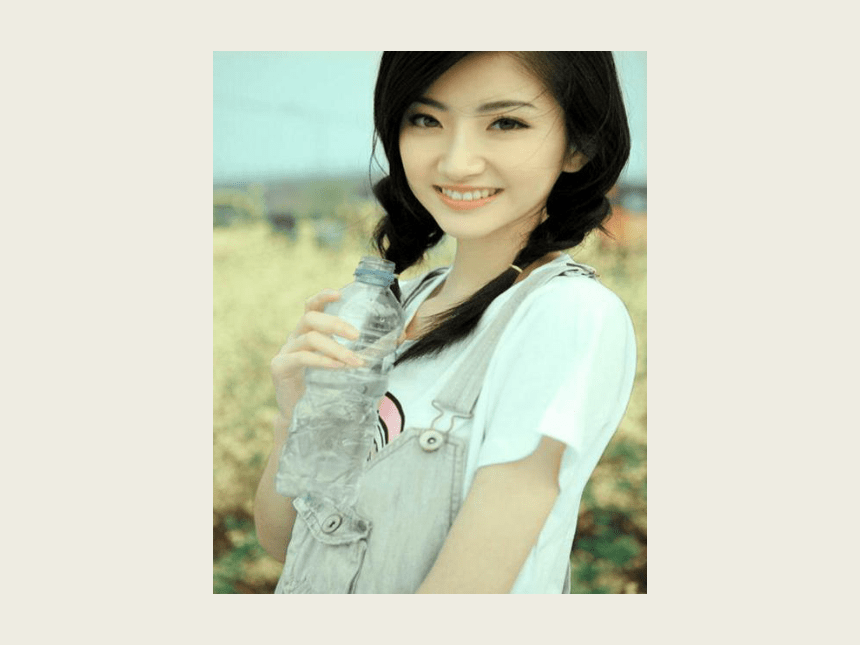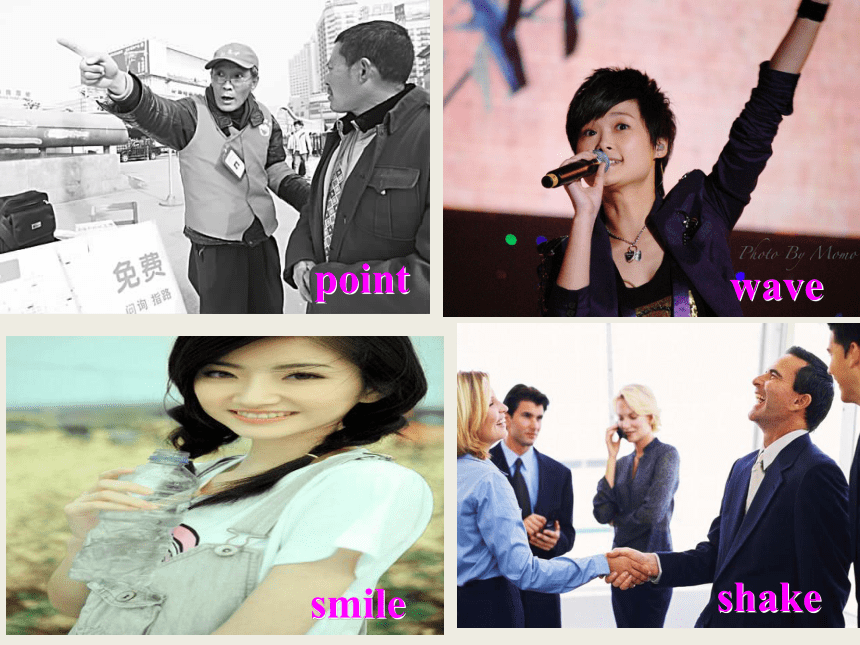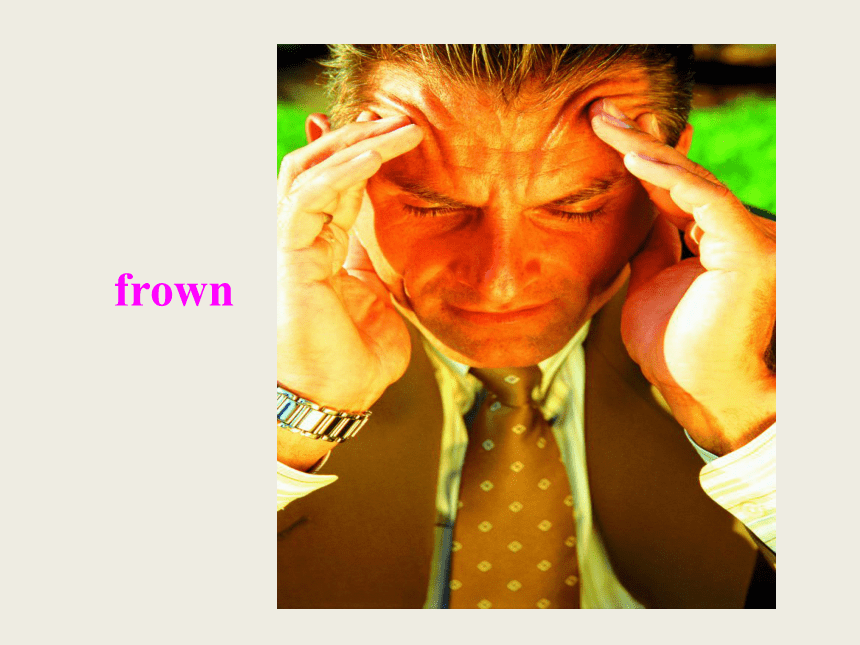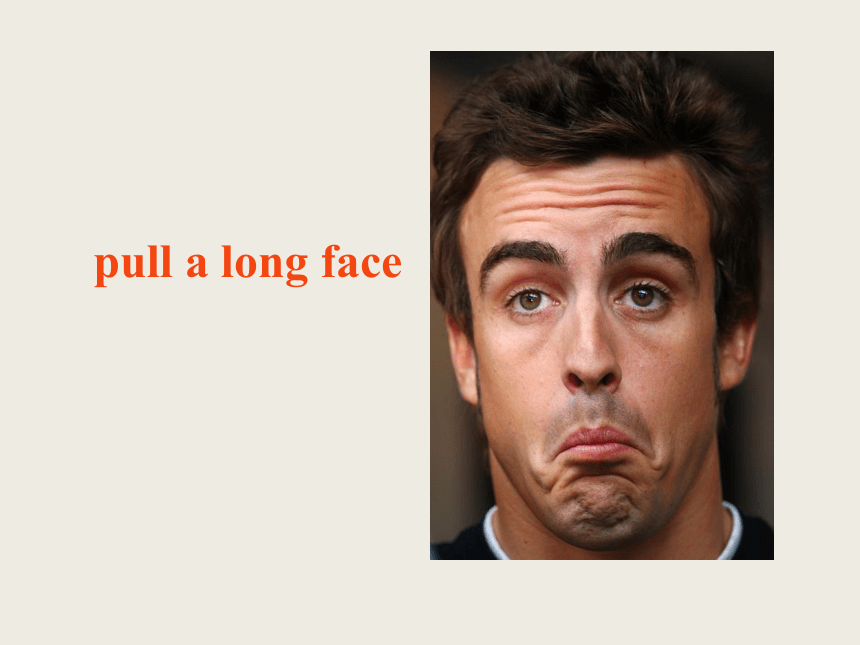外研版必修4高中英语-Module 3 Body Language and Non-Verbal Communication Introduction课件(共24张)
文档属性
| 名称 | 外研版必修4高中英语-Module 3 Body Language and Non-Verbal Communication Introduction课件(共24张) |  | |
| 格式 | zip | ||
| 文件大小 | 2.3MB | ||
| 资源类型 | 教案 | ||
| 版本资源 | 外研版 | ||
| 科目 | 英语 | ||
| 更新时间 | 2019-04-14 09:15:00 | ||
图片预览









文档简介
课件24张PPT。IntroductionNow match the verbs in the box with the pictures: point shake smile wave point wave smile shakegiggle frownpull a long facehang one’s head shrug one’s shoulderShrug one’s shoulderembracepoint point to 和point at 都含有“指着”的意思, 两者一般可以相互换用。
The teacher is pointing at (to) the map on the wall.
老师指着墙上的地图。
但主语是事物时, 一般用point to作谓语。point at可以分开使用, 即point 后直接跟名词或代词作宾语, 再跟介词at 表示方向, 意为“把……指向”, 而point to 却不得分开使用。
The soldier pointed his gun at the doctor.
士兵用枪指着医生。point out 意为“指出”, 其中out是副词。如果它后面的宾语是代词, 则必须把该宾语放在out之前。
Luckily the man knew Mr. Green and pointed him out to us.
幸好这个人认识格林先生, 于是便把他指给我们看。point out 后面还可以接宾语从句。
Please point out where I was wrong.
Look at the pictures and guess what the people are doing.point
wave
smile
shake 1. The two youths are talking. The boy is _________ the way.
2. The lady is _________ her hand, she is likely to say “goodbye” to somebody.
3. The white men is ________, maybe he is welcoming the black man.
4. The two middle-aged men are ________ hands, perhaps they are greeting.pointingwavingsmilingshakingSay what you do when you …
Example: be introduced to someone.
I shake hands and say, “Pleased to meet you.” meet a friendI shake hands and say, “ Pleased to meet you.”2. show someone the way
3. see a friend in the distance
4. enter a friend’s houseI point in the direction they must go. I wave my hand.I shake hands and say, “Hello, pleased to see you.”5. say yes
6. say no
7. say who? Me?I nod my head up and down.I shake my head from side to side. I point to myself and put on a surprised expression. 1. How much do you communicate with your body? A.?Not at all B. Not much C. A lot D. Perhaps more than I think. E. Perhaps more than with words.
2.?Can you give reasons for your choice (s)? Read and answer the questions. Thank you!
The teacher is pointing at (to) the map on the wall.
老师指着墙上的地图。
但主语是事物时, 一般用point to作谓语。point at可以分开使用, 即point 后直接跟名词或代词作宾语, 再跟介词at 表示方向, 意为“把……指向”, 而point to 却不得分开使用。
The soldier pointed his gun at the doctor.
士兵用枪指着医生。point out 意为“指出”, 其中out是副词。如果它后面的宾语是代词, 则必须把该宾语放在out之前。
Luckily the man knew Mr. Green and pointed him out to us.
幸好这个人认识格林先生, 于是便把他指给我们看。point out 后面还可以接宾语从句。
Please point out where I was wrong.
Look at the pictures and guess what the people are doing.point
wave
smile
shake 1. The two youths are talking. The boy is _________ the way.
2. The lady is _________ her hand, she is likely to say “goodbye” to somebody.
3. The white men is ________, maybe he is welcoming the black man.
4. The two middle-aged men are ________ hands, perhaps they are greeting.pointingwavingsmilingshakingSay what you do when you …
Example: be introduced to someone.
I shake hands and say, “Pleased to meet you.” meet a friendI shake hands and say, “ Pleased to meet you.”2. show someone the way
3. see a friend in the distance
4. enter a friend’s houseI point in the direction they must go. I wave my hand.I shake hands and say, “Hello, pleased to see you.”5. say yes
6. say no
7. say who? Me?I nod my head up and down.I shake my head from side to side. I point to myself and put on a surprised expression. 1. How much do you communicate with your body? A.?Not at all B. Not much C. A lot D. Perhaps more than I think. E. Perhaps more than with words.
2.?Can you give reasons for your choice (s)? Read and answer the questions. Thank you!
